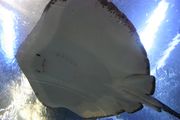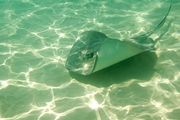Stingray
| Stingrays Fossil range: Late Cretaceous–Recent[1] |
|
|---|---|
 |
|
| Southern stingray (Dasyatis americana) | |
| Scientific classification | |
| Kingdom: | Animalia |
| Phylum: | Chordata |
| Class: | Chondrichthyes |
| Subclass: | Elasmobranchii |
| Order: | Myliobatiformes |
| Family: | Dasyatidae |
| Genera | |
|
Dasyatis |
|
The stingrays are a family—Dasyatidae—of rays, cartilaginous fishes related to sharks. They are common in coastal tropical and subtropical marine waters throughout the world, but the family also includes species found in warmer temperate oceans such as Dasyatis thetidis, and species entirely restricted to fresh water such as D. laosensis and Himantura chaophraya. With the exception of Pteroplatytrygon violacea, all dasyatids are demersal.[2]
They are named after the barbed stinger (actually a modified dermal denticle) on their tail, which is used exclusively in self-defense. The stinger may reach a length of approximately 35 cm, and its underside has two grooves with venom glands.[3] The stinger is covered with a thin layer of skin, the integumentary sheath, in which the venom is concentrated.[4] Some species have several stingers, and a few, notably Urogymnus asperrimus, lack a sting entirely.[5]
Other types of rays also referred to as stingrays are the river stingrays (family Potamotrygonidae), the round stingrays (families Urolophidae and Urotrygonidae), the sixgill stingray (family Hexatrygonidae), and the deepwater stingray (family Plesiobatidae). For clarity, the members of the family Dasyatidae are sometimes called whip-tail stingrays.[6]
While most dasyatids are relatively widespread and not currently threatened, there are several species (for example Taeniura meyeni, D. colarensis, D. garouaensis, and D. laosensis) where the conservation status is more problematic, leading to them being listed as vulnerable or endangered by IUCN. The status of several other species are poorly known, leading to them being listed as Data Deficient.[7]
Contents |
Behavior
Feeding

The flattened bodies of stingrays allow them to effectively conceal themselves in their environment. Stingrays do this by agitating the sand and hiding beneath it. Because their eyes are on top of their bodies and their mouths on the undersides, stingrays cannot see their prey; instead, they use smell and electro-receptors (ampullae of Lorenzini) similar to those of sharks. Stingrays feed primarily on molluscs, crustaceans, and occasionally on small fish. Some stingrays' mouths contain two powerful, shell-crushing plates, while other species only have sucking mouthparts. Stingrays settle on the bottom while feeding, often leaving only their eyes and tail visible. Coral reefs are favorite feeding grounds and are usually shared with sharks during high tide.
Reproduction
When a male is courting a female, he will follow her closely, biting at her pectoral disc. He then places one of his two claspers into her valve.
Stingrays are ovoviviparous, bearing live young in "litters" of five to thirteen. The female holds the embryos in the womb without a placenta. Instead, the embryos absorb nutrients from a yolk sac, and after the sac is depleted, the mother provides uterine "milk".[8]
Stingray injuries
Stingrays do not aggressively attack humans, and stings usually occur when a ray is accidentally stepped on.[9] Shuffling or stamping one's feet while wading through shallow water may cause stingrays to swim away. Contact with the stinger causes local trauma (from the cut itself), pain, swelling, muscle cramps from the venom, and possibly infection from bacteria later. The injury is very painful, but seldom life-threatening unless the stinger pierces a vital area.[9] The stinger usually breaks off in the wound, and surgery may be required to remove the fragments.[10] A notable fatality is that of wildlife adventurer and television personality Steve Irwin.
As food

Rays are edible, and may also be caught as food by fishing lines or spears. Stingray recipes abound throughout the world, with dried forms of the wings being most common. For example, in Singapore and Malaysia, stingray is commonly barbecued over charcoal, then served with spicy sambal sauce. Generally, the most prized parts of the stingray are the wings (flaps is the proper terminology), the "cheek" (the area surrounding the eyes), and the liver. The rest of the ray is considered too rubbery to have any culinary uses.
While not independently valuable as a food source, the stingray's capacity to damage shell fishing grounds can lead to bounties being placed on their removal.
Eco-tourism

Stingrays are usually very docile and curious, their usual reaction being to flee any disturbance, but will sometimes brush their fins past any new object they come across. Nevertheless, certain larger species may be more aggressive and should be approached with caution, as the stingray's defensive reflex (use of its poisoned stinger) may result in serious injury or death, as with the case of famed animal entertainer Steve Irwin, who was fatally stabbed by a stingray.[11]
Dasyatids are not normally visible to swimmers, but divers and snorkelers may find them in shallow sandy waters, more so when the water is warm. In the Cayman Islands there are several dive sites called Stingray City, Grand Cayman, where divers and snorkelers can swim with large southern stingrays (D. americana) and feed them by hand. There is also a "Stingray City" in the sea surrounding the Caribbean island of Antigua. It consists of a large, shallow reserve where the rays live, and snorkeling is possible.
In Belize off the island of Ambergris Caye there is a popular marine sanctuary called Hol Chan. Here, divers and snorkelers often gather to watch stingrays and nurse sharks that are drawn to the area by tour operators who feed the animals.
Many Tahitian island resorts regularly offer guests the chance to "feed the stingrays and sharks". This consists of taking a boat to the outer lagoon reefs then standing in waist-high water while habituated stingrays swarm around, pressing right up against tourists seeking food from their hands or that being tossed into the water. The boat owners also "call in" sharks which, when they arrive from the ocean, swoop through the shallow water above the reef and snatch food offered to them.
Other uses
The skin of the ray (same in Japanese) is used as an under layer for the cord or leather wrap (known as ito in Japanese) on Japanese swords due to its hard, rough, texture that keeps the braided wrap from sliding on the handle during use. They are also used to make exotic shoes. They are used to make boots, belts, wallets, jackets, and even cellphone cases.[12]
Several ethnological sections in museums such as the British Museum display arrowheads and spearheads made of stingray stingers, used in Micronesia and elsewhere.
Henry de Monfreid states in his books that before World War II, in the Horn of Africa, whips were made from the tail of big stingrays, and that this device inflicted cruel cuts, so in Aden the British forbid its use on women and slaves. In former Spanish colonies a stingray is called raya làtigo ("whip ray").
Monfreid also writes in several places about men of his crew suffering stingray wounds while stranding and wading into Red Sea shallows to load or unload smuggled wares: he wrote that to "save the man's life" searing the wound with a red-hot iron was necessary.
Fossils

Although stingray teeth are rare on sea bottoms compared to the similar shark teeth, scuba divers searching for the latter do encounter the teeth of stingrays. Permineralized stingray teeth have been found in sedimentary deposits around the world, including fossiliferous outcrops in Morocco.
Genera
- Dasyatis Rafinesque, 1810
- Himantura Müller and Henle, 1837
- Makararaja Roberts, 2007
- Neotrygon Castelnau, 1873
- Pastinachus Rüppell, 1829
- Pteroplatytrygon Fowler, 1910
- Taeniura Müller and Henle, 1837
- Urogymnus Müller and Henle, 1837
References
- ↑ Froese, Rainer, and Daniel Pauly, eds. (2009). "Dasyatidae" in FishBase. January 2009 version.
- ↑ Bester, C., H. F. Mollett, & J. Bourdon. "Pelagic Stingray". Florida Museum of Natural History, Ichthyology department. http://www.flmnh.ufl.edu/fish/gallery/descript/pelagicstingray/pelagicstingray.html.
- ↑ Ternay, A.. "Dangerous and Venomous Aquarium Fish". fishchannel.com. http://www.fishchannel.com/media/fish-magazines/aquarium-fish-international/july-2008/venom2.aspx.pdf.
- ↑ Meyer, P. (1997). "Stingray injuries". Wilderness Environ Med 8 (1): 24–8. PMID 11990133.
- ↑ Froese, Rainer, and Daniel Pauly, eds. (2009). "Urogymnus asperrimus" in FishBase. September 2009 version.
- ↑ Debelius, H. (1993). Indian Ocean Tropical Fish Guide. Aquaprint Verlags GmbH. ISBN 3-927991-01-5.
- ↑ "IUCN Red List". International Union for Conservation of Nature. http://www.iucnredlist.org/.
- ↑ Florida Museum of Natural History Ichthyology Department: Atlantic Stingray
- ↑ 9.0 9.1 Slaughter RJ, Beasley DM, Lambie BS, Schep LJ (2009). "New Zealand's venomous creatures". N Z Med J 122 (1290): 83–97. PMID 19319171.
- ↑ Flint D, Sugrue W (1999). "Stingray injuries: a lesson in debridement". N Z Med J 112 (1086): 137–8. PMID 10340692.
- ↑ ^ a b c "Croc Hunter Irwin killed by stingray". The Age. 4 September 2006. http://www.theage.com.au/news/National/Croc-Hunter-Steve-Irwin-died-instantly/2006/09/04/1157222051588.html. Retrieved 2010-08-11.
- ↑ [1]
Bibliography
- Froese, Rainer, and Daniel Pauly, eds. (2005). "Dasyatidae" in FishBase. August 2005 version.
External links
- University of Pennsylvania Health System – Information on stingray poison.
- Life In The Fast Lane: Toxicology Conundrum #012